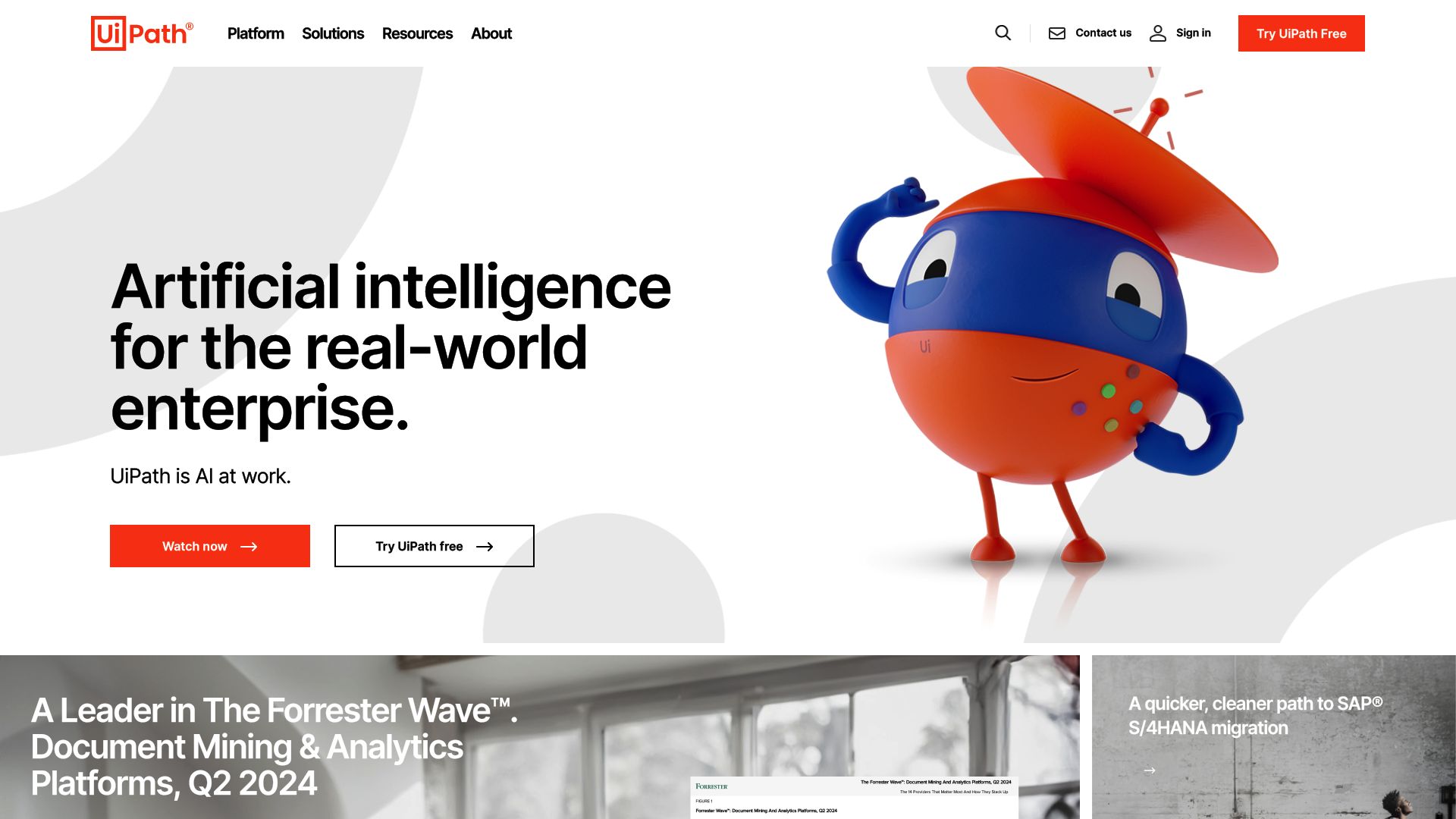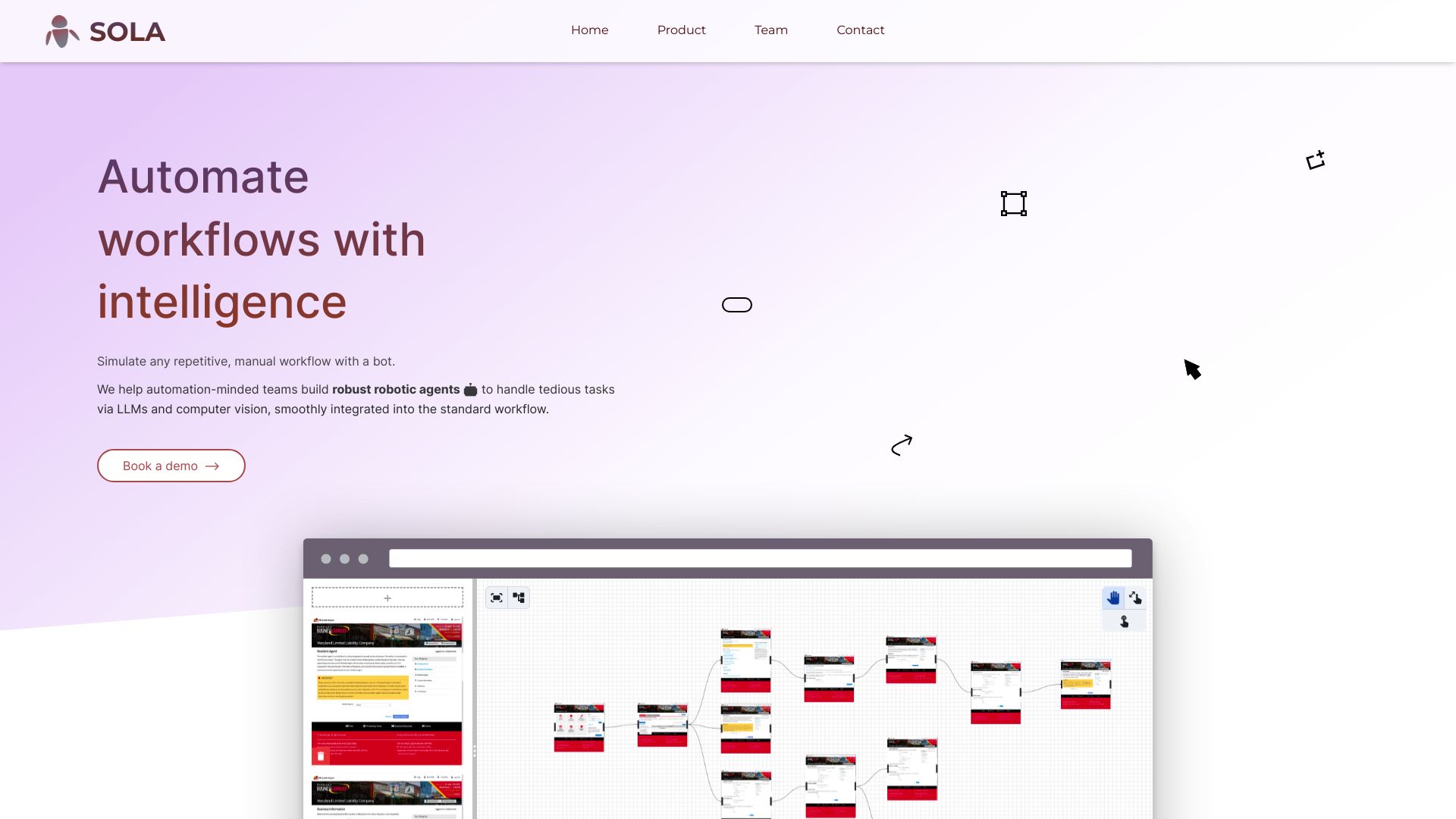UiPath vs. Sola: AI-Powered Automation Platforms Compared
AI-powered automation reshapes business operations, driving efficiency and innovation across industries. Our comparison of UiPath vs. Sola, and SmythOS reveals distinct approaches to workflow automation and AI integration. UiPath offers robust RPA capabilities for enterprise-scale deployments, while Sola provides accessible AI-powered workflow tools.
SmythOS emerges as a comprehensive solution, combining intuitive design with advanced AI capabilities and unmatched flexibility. This analysis equips decision-makers with insights to choose the ideal platform for their organization’s unique automation needs, whether streamlining repetitive tasks or implementing complex AI-driven processes.
UiPath Overview
UiPath revolutionizes enterprise automation with its comprehensive platform. The company’s flagship product, UiPath Enterprise Platform, empowers organizations to discover, build, manage, and measure automation across departments. This robust solution caters to businesses seeking to streamline operations, enhance productivity, and drive digital transformation.
The UiPath Enterprise Platform excels in automating repetitive tasks, complex workflows, and data-intensive processes. Its versatility shines in use cases ranging from finance and accounting to customer service and IT operations. For instance, UiPath robots can efficiently process invoices, handle customer inquiries, or manage IT tickets, freeing human workers to focus on higher-value tasks.
UiPath revolutionizes enterprise automation… empowers organizations to discover, build, manage, and measure automation across departments.


Key features of the UiPath platform include its visual builder, UiPath Studio, which allows users to create automation workflows through an intuitive drag-and-drop interface. The platform also offers AI capabilities through UiPath AI Center, enabling the integration of machine learning models into automation processes. For enterprise-scale deployments, UiPath Orchestrator provides centralized management and monitoring of robotic processes.
UiPath Studio… allows users to create automation workflows through an intuitive drag-and-drop interface.
While UiPath offers powerful automation capabilities, users should consider potential challenges. The platform’s extensive feature set may require a significant learning curve for non-technical users. Additionally, while UiPath provides robust RPA functionality, it may not offer the same level of general AI problem-solving capabilities as some specialized AI platforms.
UiPath integrates seamlessly with a wide array of business applications and systems, supporting both on-premises and cloud deployments. This flexibility allows organizations to incorporate UiPath automation into their existing technology stack without major disruptions. In the competitive landscape of enterprise automation, UiPath stands out for its comprehensive RPA capabilities, strong AI integration potential, and scalability for large-scale deployments.
Sola Overview
Sola offers an AI-powered workflow automation platform designed to streamline repetitive tasks across various industries. The software leverages Large Language Models and computer vision to create intelligent bots capable of handling data entry, scraping, and filing processes.


Sola’s platform features a Workflow Recorder that captures on-screen processes, an Annotation Editor for labeling steps, and a Bot Builder for converting annotated workflows into AI-powered bots. These tools enable users to create automation solutions within minutes, without requiring extensive coding knowledge.
Sola’s platform features a Workflow Recorder that captures on-screen processes, an Annotation Editor for labeling steps, and a Bot Builder for converting annotated workflows into AI-powered bots.
The software integrates seamlessly with major browsers and desktop applications, allowing for versatile automation across different platforms. Sola’s bots possess adaptive learning capabilities, improving their performance over time as they encounter new scenarios.
While Sola excels in automating repetitive tasks, it lacks some advanced features found in more comprehensive AI agent builders. The platform doesn’t offer autonomous agents or multimodal capabilities, limiting its applicability in complex AI scenarios. Additionally, Sola doesn’t provide native support for deploying automations as site chat solutions or GPT models, which may restrict its use in certain conversational AI applications.
Despite these limitations, Sola’s focus on intuitive design and quick bot creation makes it an attractive option for businesses looking to streamline their workflows, particularly in sectors like legal, finance, insurance, and healthcare. The platform’s ability to adapt and incorporate new logic automatically positions it as a valuable tool for organizations seeking to enhance their operational efficiency through AI-powered automation.
Feature Comparison
UiPath and Sola offer distinct approaches to workflow automation, each with its own strengths and limitations. UiPath excels in robotic process automation (RPA) with a comprehensive enterprise-grade platform. It provides powerful tools for process discovery, automation development, and orchestration. UiPath’s visual builder, UiPath Studio, enables users to create complex workflows through an intuitive drag-and-drop interface. The platform also integrates AI capabilities via UiPath AI Center, allowing seamless incorporation of machine learning models into automation processes.
In contrast, Sola focuses on AI-powered workflow automation, leveraging Large Language Models and computer vision. Sola’s platform features a Workflow Recorder for capturing on-screen processes and an Annotation Editor for labeling steps. While this approach simplifies bot creation for users without extensive coding knowledge, it may lack the depth and flexibility offered by UiPath’s more comprehensive RPA toolkit.
UiPath’s enterprise focus becomes evident in its robust security features and scalability options, which may surpass Sola’s offerings. UiPath provides detailed audit logs, IP whitelisting, and support for multiple environments, catering to large-scale deployments. Sola, while adaptable, may not match UiPath’s enterprise-grade security and compliance features, potentially limiting its suitability for certain industries or large organizations with stringent regulatory requirements.
Feature Comparison Table
| UiPath | Sola | SmythOS | |
|---|---|---|---|
| CORE FEATURES | |||
| AI Agents | ❌ | ✅ | ✅ |
| Hosted Agents (Dev, Production) | ❌ | ❌ | ✅ |
| No-Code Options | ❌ | ✅ | ✅ |
| Memory & Context | ❌ | ✅ | ✅ |
| Autonomous Agents | ❌ | ✅ | ✅ |
| Explainability & Transparency | ❌ | ✅ | ✅ |
| Debug Tools | ✅ | ❌ | ✅ |
| Multimodal | ❌ | ❌ | ✅ |
| Problem-Solving Capabilities | ❌ | ✅ | ✅ |
| Multi-Agent Collaboration | ❌ | ❌ | ✅ |
| Work as Team | ❌ | ❌ | ✅ |
| SECURITY | |||
| Constrained Alignment | ❌ | ❌ | ✅ |
| IP Control | ✅ | ❌ | ✅ |
| COMPONENTS | |||
| Foundation AIs | ❌ | ✅ | ✅ |
| Huggingface AIs | ❌ | ❌ | ✅ |
| Zapier APIs | ❌ | ❌ | ✅ |
| Classifiers | ❌ | ❌ | ✅ |
| Data Lakes | ❌ | ❌ | ✅ |
| DEPLOYMENT OPTIONS (EMBODIMENTS) | |||
| Deploy as API | ❌ | ✅ | ✅ |
| Deploy as Webhook | ❌ | ✅ | ✅ |
| Staging Domains | ❌ | ❌ | ✅ |
| Production Domains | ❌ | ❌ | ✅ |
| Deploy as Site Chat | ❌ | ✅ | ✅ |
| Deploy as Scheduled Agent | ❌ | ✅ | ✅ |
| Deploy as GPT | ❌ | ❌ | ✅ |
| DATA LAKE SUPPORT | |||
| Hosted Vector Database | ❌ | ❌ | ✅ |
| Sitemap Crawler | ❌ | ❌ | ✅ |
| YouTube Transcript Crawler | ❌ | ❌ | ✅ |
| URL Crawler | ❌ | ✅ | ✅ |
| TXT File Support | ❌ | ✅ | ✅ |
Best Alternative to UiPath and Sola
SmythOS stands out as the superior alternative to UiPath and Sola for AI-driven workflow automation. Our platform combines the best of both worlds, offering enterprise-grade capabilities with user-friendly AI agent creation. SmythOS enables rapid development and deployment of intelligent agents that can handle complex tasks across industries.
SmythOS stands out as the superior alternative to UiPath and Sola for AI-driven workflow automation… offering enterprise-grade capabilities with user-friendly AI agent creation.
Unlike UiPath’s focus on traditional RPA, SmythOS leverages cutting-edge AI to create truly autonomous agents. Our visual builder surpasses Sola’s limited workflow recorder, allowing users to craft sophisticated AI workflows without coding. SmythOS agents possess advanced reasoning and problem-solving abilities that go far beyond simple task automation.
We designed SmythOS for unlimited use cases, from customer service chatbots to data analysis to process automation. Our platform seamlessly integrates with existing systems and supports deployment across multiple environments. This flexibility, combined with enterprise-grade security features, makes SmythOS ideal for organizations of all sizes.
SmythOS provides a comprehensive AI operating system to revolutionize your workflows… empower businesses to automate complex processes end-to-end.
While UiPath and Sola offer niche solutions, SmythOS provides a comprehensive AI operating system to revolutionize your workflows. Our multi-agent collaboration, explainable AI, and scalable architecture empower businesses to automate complex processes end-to-end. With SmythOS, you can harness the full potential of AI to drive unprecedented efficiency and innovation across your organization.
Conclusion
UiPath, Sola, and SmythOS each offer unique approaches to automation and AI integration, catering to different needs within the enterprise software landscape. UiPath excels in robust RPA capabilities and enterprise-grade features, making it suitable for large organizations with complex automation requirements. Sola provides an accessible platform for AI-powered workflow automation, particularly appealing to businesses seeking quick bot creation without extensive coding.
However, SmythOS emerges as the superior choice, offering a comprehensive solution that combines the strengths of both platforms while addressing their limitations. Our drag-and-drop interface rivals UiPath’s Studio in intuitiveness, while our AI capabilities surpass Sola’s offerings. SmythOS’s ability to deploy agents across multiple platforms, including as APIs, chatbots, and scheduled tasks, provides unparalleled flexibility.
SmythOS’s extensive integration ecosystem, supporting over 300,000 integrations, sets it apart from competitors. This vast array of connections allows businesses to seamlessly incorporate AI into existing workflows, regardless of the tools they currently use. Our platform’s support for multimodal interactions and advanced problem-solving capabilities opens up new possibilities for automation that go beyond simple task replication.
For those ready to experience the future of AI-powered automation, we invite you to explore our diverse range of AI-powered agent templates. These templates offer a quick start to revolutionizing your workflows across various business functions. To see how SmythOS can transform your operations, create a free SmythOS account and start building unlimited AI agents at no cost. With our 30-day money-back guarantee, you can confidently test the full potential of AI workforce automation risk-free.
Last updated:
Disclaimer: The information presented in this article is for general informational purposes only and is provided as is. While we strive to keep the content up-to-date and accurate, we make no representations or warranties of any kind, express or implied, about the completeness, accuracy, reliability, suitability, or availability of the information contained in this article.
Any reliance you place on such information is strictly at your own risk. We reserve the right to make additions, deletions, or modifications to the contents of this article at any time without prior notice.
In no event will we be liable for any loss or damage including without limitation, indirect or consequential loss or damage, or any loss or damage whatsoever arising from loss of data, profits, or any other loss not specified herein arising out of, or in connection with, the use of this article.
Despite our best efforts, this article may contain oversights, errors, or omissions. If you notice any inaccuracies or have concerns about the content, please report them through our content feedback form. Your input helps us maintain the quality and reliability of our information.
